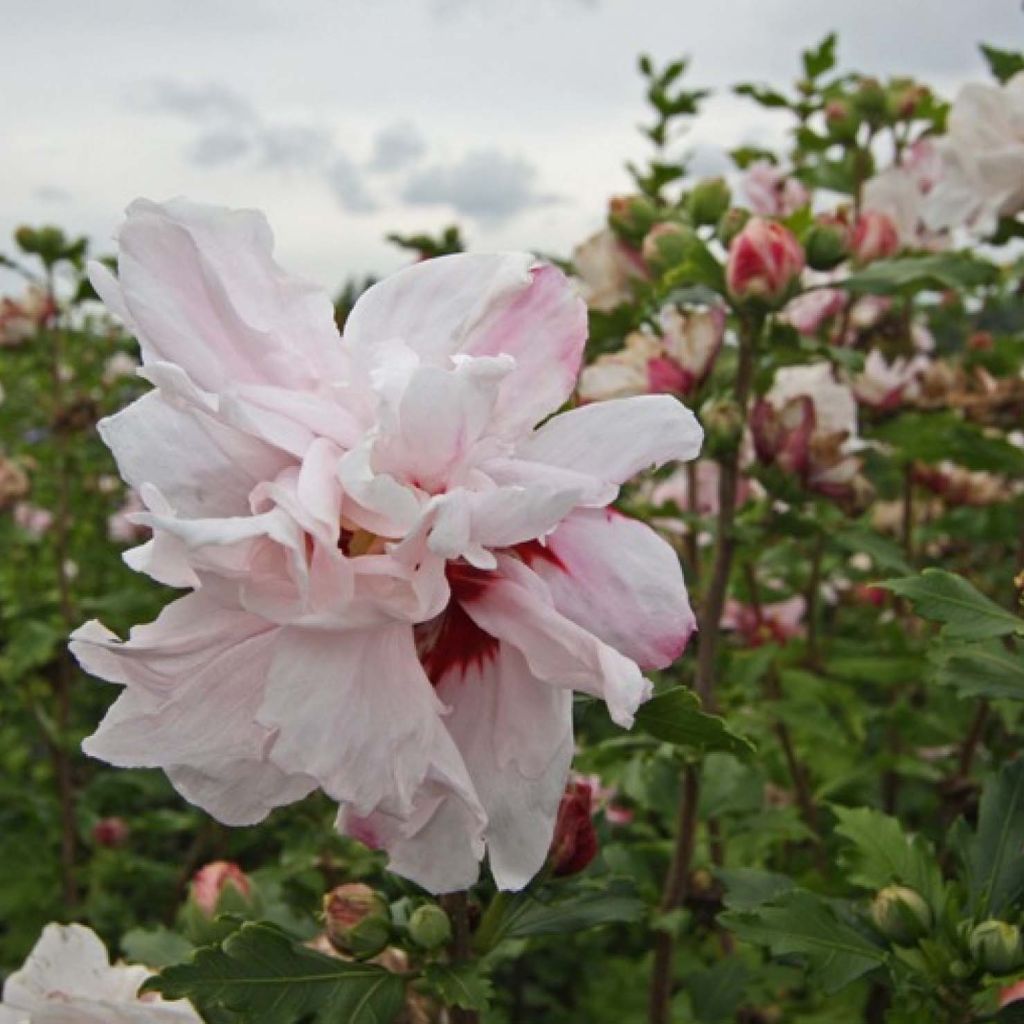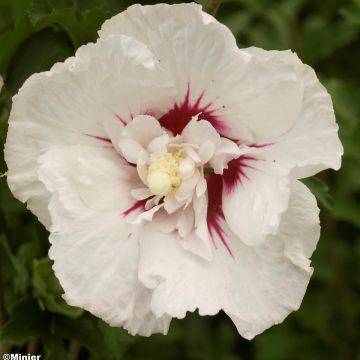

Hibiscus syriacus Leopoldii - Rose of Sharon
Hibiscus syriacus Leopoldii - Rose of Sharon
Hibiscus syriacus Leopoldii
Common Hibiscus, Rose of Sharon, Syrian ketmia, St Joseph's rod, Garden Hibiscus
This item cannot be shipped to the selected country
Delivery charge from €6.90
More information
Delivery charge from €6.90
More information
Schedule delivery date,
and select date in basket
This plant carries a 24 months recovery warranty
More information
We guarantee the quality of our plants for a full growing cycle, and will replace at our expense any plant that fails to recover under normal climatic and planting conditions.
From €7.90 for pickup delivery and €6.90 for home delivery
Express home delivery from €8.90.
Does this plant fit my garden?
Set up your Plantfit profile →
Description
The Hibiscus syriacus 'Leopoldii' is an old variety of tree mallow that still charms with the beauty and abundance of its large pale pink flowers with crumpled hearts, speckled with red. This generous bush blooms from July to October, as long as it is mild, and it perfectly withstands cold winters despite its exotic appearance. It deserves a prominent place near the house, as a standalone plant in the centre of a perennial border, or even in a large container on the terrace. Hibiscus syriacus is easily grown in non-scorching sun or partial shade, in slightly moist soil, even limestone, in all climates.
The Hibiscus syriacus, sometimes called Garden Hibiscus, is a hardy deciduous bush in our climates, but evergreen in warm climates, belonging to the mallow family, just like hollyhocks and marshmallows. It is native to temperate regions of Asia and has given rise to numerous cultivars, including the lovely Leopoldii variety, parent of the very beautiful 'French Cabaret'. This bush, with fairly slow growth, has an upright, bushy, somewhat stiff habit. It will not exceed 2.50 m (8 ft 2 in) in height and 1.50 m (4 ft 11 in) in width. Its foliage is dense, fairly dark green, slightly glossy, and strongly serrated along the edges. It turns yellow in November before falling and appears quite late in spring. Flowering begins in July and continues until September-October. Each flower only lives for one day, but they are produced in large numbers on the branches. The Leopoldii variety offers corollas of 7-8 cm (2.8-3.1 in) in pale pink cups, sometimes striped red, with a dark red centre and a tangle of smaller petals.
The 'Leopoldii' Althaea likes bright, warm exposure and can tolerate light shade in warmer climates. Plant it sheltered from strong winds, in a soil that remains slightly moist until the end of summer to support flowering and the freshness of its foliage. This truly charming bush is not delicate and high-maintenance. It can be planted in all areas, especially in small gardens. It pairs well with pink or white shrubby lavenders as well as other flowering bushes like buddleias or repeat-flowering roses. Hibiscus syriacus is often planted in flowering hedges, mixing varieties for a beautiful multicoloured effect. It can also be grown in a large container, in fertile soil, to fully enjoy its flowering on the terrace.
Hibiscus syriacus Leopoldii - Rose of Sharon in pictures


Plant habit
Flowering
Foliage
Botanical data
Hibiscus
syriacus
Leopoldii
Malvaceae
Common Hibiscus, Rose of Sharon, Syrian ketmia, St Joseph's rod, Garden Hibiscus
Cultivar or hybrid
Other Hibiscus
View all →Planting and care
Plant the 'Leopoldii' Hibiscus syriacus for the best results in spring or autumn. Choose a sunny spot or a partially shaded area if you live in hotter regions. Ensure that the soil is well-drained, loose, and fertile. Add some compost and sand to your garden soil to improve its quality. After planting, water the plant generously. Don't be alarmed if you don't see any growth before May - this is normal for this type of bush.
Although altheas can tolerate heat and occasionally dry soils, they thrive in soils that retain moisture. If necessary, mulch the base of these bushes. This will help the soil retain moisture, making the bushes more beautiful and floriferous.
Planting period
Intended location
Care
-
, onOrder confirmed
Reply from on Promesse de fleurs
Similar products
Haven't found what you were looking for?
Hardiness is the lowest winter temperature a plant can endure without suffering serious damage or even dying. However, hardiness is affected by location (a sheltered area, such as a patio), protection (winter cover) and soil type (hardiness is improved by well-drained soil).

Photo Sharing Terms & Conditions
In order to encourage gardeners to interact and share their experiences, Promesse de fleurs offers various media enabling content to be uploaded onto its Site - in particular via the ‘Photo sharing’ module.
The User agrees to refrain from:
- Posting any content that is illegal, prejudicial, insulting, racist, inciteful to hatred, revisionist, contrary to public decency, that infringes on privacy or on the privacy rights of third parties, in particular the publicity rights of persons and goods, intellectual property rights, or the right to privacy.
- Submitting content on behalf of a third party;
- Impersonate the identity of a third party and/or publish any personal information about a third party;
In general, the User undertakes to refrain from any unethical behaviour.
All Content (in particular text, comments, files, images, photos, videos, creative works, etc.), which may be subject to property or intellectual property rights, image or other private rights, shall remain the property of the User, subject to the limited rights granted by the terms of the licence granted by Promesse de fleurs as stated below. Users are at liberty to publish or not to publish such Content on the Site, notably via the ‘Photo Sharing’ facility, and accept that this Content shall be made public and freely accessible, notably on the Internet.
Users further acknowledge, undertake to have ,and guarantee that they hold all necessary rights and permissions to publish such material on the Site, in particular with regard to the legislation in force pertaining to any privacy, property, intellectual property, image, or contractual rights, or rights of any other nature. By publishing such Content on the Site, Users acknowledge accepting full liability as publishers of the Content within the meaning of the law, and grant Promesse de fleurs, free of charge, an inclusive, worldwide licence for the said Content for the entire duration of its publication, including all reproduction, representation, up/downloading, displaying, performing, transmission, and storage rights.
Users also grant permission for their name to be linked to the Content and accept that this link may not always be made available.
By engaging in posting material, Users consent to their Content becoming automatically accessible on the Internet, in particular on other sites and/or blogs and/or web pages of the Promesse de fleurs site, including in particular social pages and the Promesse de fleurs catalogue.
Users may secure the removal of entrusted content free of charge by issuing a simple request via our contact form.



















































